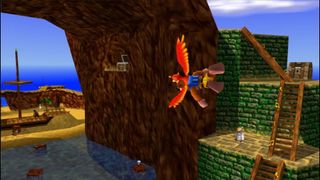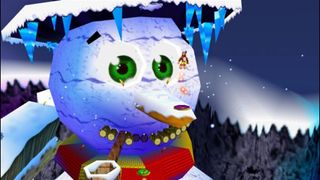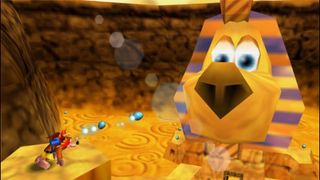Rare’s famous bird-and-bear platformer passed me by when it hit the Nintendo 64 back in 1998, despite my abiding love of Super Mario 64. Gazing at stills and unbearably small, choppy videos on the Internet it looked like an overly chatty, bug-eyed imitation of Nintendo’s brilliant foray into the third-dimension. Even playing Banjo Kazooie now - the HD re-release newly on Xbox One thanks to Rare Replay - the impression holds up. This is as close to 'Super Mario 64 2' as we ever got.
Gruntilda’s castle may not be the palace of sunny, bright color that the house of Peach is, but Banjo explores it in an almost identical way to Mario. Wandering the halls, you find jigsaw puzzle pieces that fit into larger portraits of fantastical places like a pirate cove. Complete a portrait and a door opens to the pictured themed locale, where you can find even more jigsaw pieces as well as golden notes hanging in the air. Banjo needs those notes to open even more doors in the castle, just like Mario needs his stars. And how does he collect all those bits and bobs? By jumping, flipping, and flying around, learning new moves in an expansive repertoire of acrobatics. So Banjo flies because his bird bestie Kazooie finds some magic feathers instead of using a magical hat; the principal is exactly the same.

Only it’s not the same, though, a fact only further enhanced by a modern gaming perspective. Part of what makes Mario 64 feel so constrained in 2015 is the structure for finding each stage’s stars, those glowing baubles that let you progress further and further into the castle. Every time you enter one of that game’s portraits, you’re given a hint on how to find a specific star - but it also regularly restricts your access to other stars hidden in the same stage. And even when you find one, you’re kicked right out of the stage and back to the castle itself.
Banjo Kazooie, meanwhile, has a keener respect for the player that wants to completely inhabit the space. Once you’re in a level like Clanker’s Cavern, a distinctly dank pit of despair, you can explore to your heart’s content. Every single puzzle piece, note, and other collectible doodad might not be uncovered on your first visit through, but your freedom to explore is unfettered by a needlessly restrictive game structure. Realizing that I wasn’t going to be constantly kicked out of the stage, watching some summary of how many coins I collected in addition to my latest puzzle piece, I found myself warming up more and more to Banjo Kazooie. Its stages felt coherent and complete, and my freedom to discover them uninterrupted lent them a feeling of fullness that Mario 64 only has in my memory, rather than when I actually play it.

That’s not to say that Banjo Kazooie is totally free of needling anachronisms seventeen years after it first came out. While it’s a hell of a lot of fun to play, it’s also a pain to control, even compared to its direct inspiration. Part of what keeps Super Mario 64 playable all these years later is the ease of movement. Mario is versatile, capable of sky-high triple jumps and ground pounds galore, but using his moves is incredibly simple. Even the most complex maneuver requires just a couple of button presses. Meanwhile, pulling off all of Banjo’s moves requires all kinds of different button combinations.
What trigger do I need to hold to make Kazooie run? What makes her shoot eggs? How do I do a flip jump, and why is that different than the super high jump I can only do on certain special pads in stages? Not only is locomotion jarringly awkward, but you don’t even have access to the duo’s full range of motion at the start. Moves have to be learned by a little mole hiding throughout the castle and portraits, and you can’t use them before that. Restricting your access to moves is a teaching method still used in many modern games, and it’s as annoying now as it was when Banjo was made.

Even with its cumbersome controls, Banjo still feels just right once you fall into its particular rhythms. Climbing up and down the nasty green hallways of Grunty’s castle, it dawned on me that even if Super Mario 64’s model for 3D platformers was an evolutionary dead end, there was still an incredible amount of space left for refinement in its wake. Few developers actually took advantage of the opportunity. Sure, there were other contenders to the throne, but no 3D platformer from the past twenty years mimicked Mario 64 so precisely. Even Rare’s own work like Conker's Bad Fur Day and Donkey Kong 64 deviated from the structural style of a giant hub full of smaller places to explore.
Playing Banjo Kazooie for the first time felt weird. Having grown accustomed to 3D games that do so much of your moving for you, it was hard to get used to the way that weird bird and her bear bud ran around. Once I got past that hurdle, though, I found a game that did what Mario 64 couldn’t do for me anymore. The closer I got to Banjo Kazooie, the deeper in I went, and the bigger it felt. As much as it was (and still is) an imitator of one of gaming’s most iconic works, it endures all on its own, welcoming to anyone willing to jump in.

